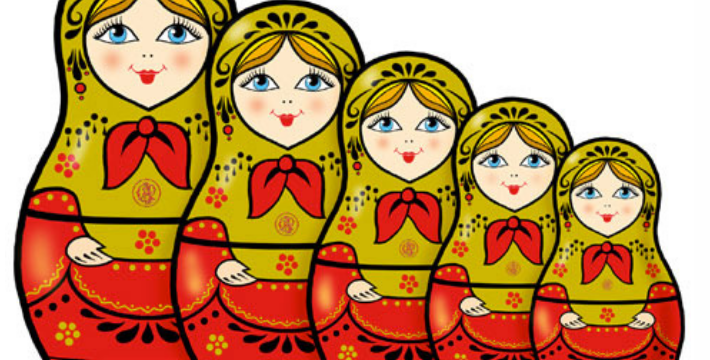The word matrioska has a connection with the Latin word mater.
Matrioska is a Russian word used as a diminutive of the name matron, as the head of the family in a matriarchal society.
As well as with the Latin word “matrix” or “matrix” which means mother, uterus. Matrix, therefore, implies as that which generates, which determines.
The matrioska symbolically represents the mother figure and is related to the fertility of the woman and also of the earth.
The matrioska doll was “born” in Russia, from a Japanese doll, as a representation of a peasant woman, painted with vibrant colors and dressed in typical Russian costumes.
The original matrioska was made up of four peasant women and a newborn (called a seed), with clear reference to maternity and fertility.
Over time, the characters represented by the matryoshka dolls remained similar to the classic matryoshka, but we found many variations in terms of themes or the number of dolls.
For example, some matryoshka were made to represent characters from fables or protagonists of great Russian novels. Mastrioskas have even been used to represent political characters, within a historical context or simply for humor.
An interesting interpretation of the symbolic meaning of matrioska can be found in the comedy Trois et Une (Three in One) by Demys Aniel, where it is shown that each woman contains many other diverse women. Each of these women, with their own personality, one inside the other, just like the famous Russian dolls.
As a psychotherapist and teacher of courses, since I met them in the summer of 2001 in Budapest, in Eastern Europe, I use them in my work. Sometimes as symbolic acts, other times as a didactic resource, for example, to illustrate how the unconscious can be “theoretically subdivided” into five unconscious: the smallest doll (called a seed doll) I relate to the individual unconscious of Freud's Psychoanalysis; the next to the familiar unconscious of Systemic Therapy; the third to the generational family unconscious of Psychogenealogy and Family Constellations; the fourth to the group unconscious, described by Vincent De Gaulejac in Clinical Sociology, and the last to the collective unconscious proposed by Jung.
Thus, we can symbolically use this fantastic Russian doll in countless ways, such as in generational works (since they symbolically represent several generations), in symbolic acts (each doll can represent a person, a woman, a generation, etc.) and many other possibilities.
I believe that these dolls have the power to connect us with our various dimensions, going to the core of our essence or seed as the first little doll is named.
Psychologist - CRP 04/7521 Systemic Family Psychotherapist (Brazil) Psychogenealogist (Italy)







































